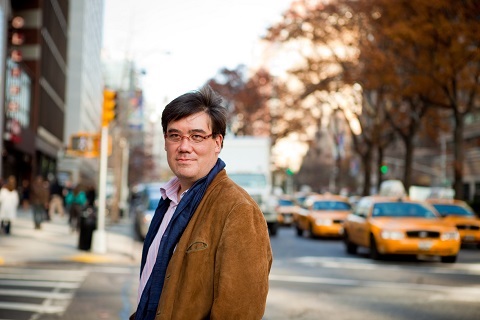 Switzerland Adès, Beethoven, Nielsen: Anon Barnatan (piano), Christina Landshamer (soprano), Benjamin Appl (Baritone), Tonhalle Orchestra Zurich / Alan Gilbert (conductor), Tonhalle Maag, Zurich, 30.3.2019. (JR)
Switzerland Adès, Beethoven, Nielsen: Anon Barnatan (piano), Christina Landshamer (soprano), Benjamin Appl (Baritone), Tonhalle Orchestra Zurich / Alan Gilbert (conductor), Tonhalle Maag, Zurich, 30.3.2019. (JR)

Adès – Three Studies from Couperin
Beethoven – Piano Concerto No.4 Op.58
Nielsen – Symphony No.3 Op.27, ‘Sinfonia Espansiva’
Thomas Adès work is usually very approachable, and Three Studies from Couperin was no exception. One of the orchestra’s Principals commented that it made a change to play a modern piece he actually liked! Adès says he likes nothing better than to spend a day at his cembalo playing Couperin and this group of three studies is Adès’s take on pieces from Couperin’s Pièces de clavecin, musical miniatures written by Couperin while Court composer in Versailles for the Sun King Louis XIV. Adès re-writes the pieces for chamber orchestra, using experimental orchestral colours, including marimba, bass drum and twisty bass flute (quite a rare sight). This is particularly striking in the opening movement ‘Les Amusemens’, where the soft sound of the marimba was particularly fetching. The central movement ‘Les Tours de Passe-Passe’ is a potpourri of motifs, whilst the last movement ‘L’Âme-en-Peine’ (‘A lost soul’) brings a degree of despondency and a funeral march. There are echoes of the neo-classical style of Pulcinella and the use of a simple nursery tune. The piece was very well received. More Adès please.
Inon Barnatan was not a name I knew. Based on this excellent performance, I am sure he has joined the group of upcoming illustrious young(ish) pianists. Born in Tel Aviv in 1979 but now living in the United States, he was Alan Gilbert’s first Artist-in-residence during Gilbert’s eight-year tenure as Chief Conductor of the New York Philharmonic and they have, according to Barnatan himself, become good friends. This season Barnatan will make his debut with the NDR Elbphilharmonie Orchestra in Hamburg, which Gilbert takes over (from Thomas Hengelbrock) in September.
Barnatan is not a tall man but cuts a dash in a dinner jacket – conservative in look, conservative in style, but I mean neither pejoratively. Beethoven’s Fourth Concerto came over with a vivid freshness and flow. Barnatan has a lovely touch on the keyboard, light as a feather or weighty, exactly as required. He was thoroughly engaged with the music, at one with the orchestra, clearly enjoying himself. The performance was technically without fault; it flew by, aided by Gilbert’s expert accompaniment. If Barnatan has a fault, he mouths rather too much – a difficult habit to break I suspect. The audience and orchestra were much taken by him and he rewarded us with a wonderful encore that had all the music-lovers (and orchestra members) guessing: it turned out to be Mendelssohn’s Rondo Capriccioso, though many listeners had plumped for Chopin.
After the interval, a viola player from the orchestra gave us an interesting introduction to Nielsen and his Third Symphony. The violist had studied in Copenhagen and even quoted Nielsen’s reaction to the première in Danish. I wish more orchestras would follow this example, common in the US but rare on this side of the Pond.
Nielsen’s Fourth (the dynamic and arresting ‘Inextinguishable’) and his striking Fifth are perhaps more frequently performed and therefore better known than his Third. But make no mistake, the Third is a very fine work and it put Nielsen on the international musical stage. Alan Gilbert recorded all the symphonies a few years ago with the New York Philharmonic; a boxed set is available (though you might be less enamoured with the First, Second and quirky Sixth Symphonies); Gilbert has evident affinity with the composer.
The opening movement of the Third Symphony is most unusual – 26 orchestral stabs on one single note, A. There follows immediately an uplifting, thrilling main theme which permeates the entire movement; there is much use of brass and timpani. We are not a million miles away from the world of Bruckner, but Walton’s First Symphony also came to mind – though that was written some 20 years later. Swathes of full orchestral sound envelop the listener; it was all too loud for one audience member in the ‘choir’ seats who changed his seat after the first movement. In fact, Gilbert had kept the brass in check in terms of volume but there was still plenty of visceral pleasure. The two internal movements have a distinct Scandinavian flavour but the music is audibly in Nielsen’s unique sound-world. In the slow movement, which is supposed to evoke Adam and Eve in the Garden of Eden, the two soloists vocalise on the sound “a”, which conjures up a wondrous effect. The last movement, utilising some folksy themes and ending with a brilliant apotheosis, is perhaps a bit too long, but as the whole symphony is over after 40 minutes, it matters not. I enjoyed it so much that I went again next evening.
Sadly, Nielsen was not a box office draw, but the Tonhalle Management should not be deterred. One orchestra member told me they were delighted not to be playing the same old warhorses.
Hopefully, therefore, we in Zurich can look forward to more Nielsen in future, either with Alan Gilbert or Paavo Järvi (or both), and I suspect we will see Inon Barnatan here again before too long.
John Rhodes